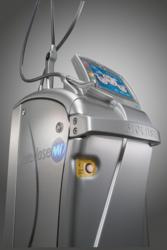Laser Dentistry
Diagnodent
We use Diagnodent, a laser decay detection system to detect hidden tooth decay, even very small lesions are detected at the earliest stage, enabling us to protect and preserve your tooth structure.
The advantages of the Diagnodent include:
- Simple, fast and painless
- It is extremely reliable
- Minimally invasive
- Early detection of changes in tooth enamel and fissures
Laser Dentistry (Waterlase®)
The Waterlase® performs a variety of dental procedures on teeth, gum and bone, making your dental experience more comfortable by reducing any anxiety you may have and providing you with a more relaxing dental experience.
With Waterlase, no drill or anaesthesia for most of the dental procedures.
We also use Waterlase to disinfect your tooth during root canal therapy as well it is used for decay removal and filling with a lot of comfort.
The Waterlase emits a laser beam that energises a spray of air and water to rapidly remove decay or to cut through bone as a drill would, but the difference is that it is more accurate, because of the absence of torque. This system improves your comfort, as no heat or vibration is incurred and is fantastic for people who do not like the sound of a conventional dental drill as the Waterlase just makes a gentle tapping sound, so patient comfort is established.
The combination of laser energy and water-spray creates hydrokinetic™ energy and is a patented technology invented by BIOLASE scientists.
Major benefits associated with laser dentistry
- Procedures performed using soft tissue dental lasers may not require sutures (stitches).
- Certain laser dentistry procedures do not require anaesthesia.
- Laser dentistry minimizes bleeding because the high-energy light beam aids in the clotting (coagulation) of exposed blood vessels, thus inhibiting blood loss.
- Bacterial infections are minimized because the high-energy beam sterilizes the area being worked on
- Damage to surrounding tissue is minimized.
- Wounds heal faster and tissues can be regenerated.
Why Laser Dentistry?
Tooth enamel is the hardest material in the human body, which is why traditionally dentists have resorted to tough tools to work on it. Old-fashioned drills and needles cause vibration, heat and pain, and contribute to the anxiety many people feel when visiting the dentist.
Today, with the advanced technology of Waterless Dentistry we can perform a wide range of dental procedures on teeth, gum and bone much more comfortably.
Combining laser energy and a spray of water, the Waterless system is engineered and designed to perform special functions without changing or damaging the surrounding tissues, and with much less pain.

The Benefits of Waterlase
The Waterlase system uses a laser beam tuned to the wavelength of a water molecule, which instantly vaporises any water at the focal point of the beam. Consequently, any tissue containing water is painlessly removed.
For different applications on hard or soft tissues, the power, length of pulse, and the amount of water and air used can be varied. The biggest benefit to patients is that many procedures can be performed with minimum tissue loss, so that you feel less discomfort and heal more rapidly.
Waterlase is a wonderful alternative to traditional drills and needles, reflecting our commitment to providing you with a great result in a relaxed environment.
Reduced Trauma – Highspeed drills can cause hairline fractures in teeth, eventually leading to future dental problems. The gentle action of the Waterlase laser reduces damage to healthy portions of the tooth, minimising trauma.
Improved Cavity Fillings – Waterlase cavity preparations help us provide stronger tooth-coloured restorations, for longer lasting fillings.
Fewer Dental Visits – With no needles or anaesthesia required, Waterlase allows us to perform cavity preparations in several areas of your mouth in one visit, rather than the hassle of multiple visits.
Less Bleeding and Swelling – With its gentle cutting action and coagulating capability, the Waterlase laser performs many procedures on gums and other soft tissues with little or no bleeding and less post-operative swelling.
Versatility – Waterlase allows us to perform a wide range of dental procedures on teeth, gum and bone more comfortably. In some cases we may also be able to use Waterlase for procedures which previously required referral to a specialist.
Gum disease is treated at Mascot Dental Centre using Laser assisted procedures resulting in faster, more comfortable treatment outcomes.
Root canals are also treated using lasers which are gentler and result in a completely cleaned tooth which ensures complete healing of the tooth quicker and more comfortably.
The uses of Waterlase
Waterlase is a very effective method for treating worn down teeth. We can use the laser to prepare the tooth surface for a secure bond for filling material, so there is no need to destroy large amounts of tooth tissue with a drill to restore the teeth to their original shape.
The Waterlase can also be used to change the shape of the gum, for example in preparation for a dental crown to ensure that the crown fits perfectly.
The laser smile lift enables us to reshape the gums around your front teeth in one visit, without surgery or stitches, and permanently improve the appearance of the front teeth as they emerge from the gums. There is very little soreness after the procedure, and instead of having to wait three months for the swelling to subside, patients can proceed to their cosmetic dentistry straight away.
Waterlase technology brings many other benefits to our patients. To find out more, please ask us about Waterlase technology at your next visit.
How Do Lasers Work in Dentistry?
All lasers work by delivering energy in the form of light. When used for surgical and dental procedures, the laser acts as a cutting instrument or a vaporizer of tissue that it comes in contact with. When used for “curing” a filling, the laser helps to strengthen the bond between the filling and the tooth. When used in teeth-whitening procedures, the laser acts as a heat source and enhances the effect of tooth-bleaching agents.
What Are the Pros and Cons of Using a Laser in Dentistry?
Pros
Compared to the traditional dental drill, lasers:
- May cause less pain in some instances, so reduces the need for anaesthesia.
- May reduce anxiety in patients uncomfortable with the use of the dental drill
- Minimize bleeding and swelling during soft tissue treatments
- May preserve more healthy tooth during cavity removal
Cons
The disadvantages of lasers are that:
- Lasers can’t be used on teeth with fillings already in place.
- Lasers can’t be used in many commonly performed dental procedures. For example, lasers can’t be used to fill cavities located between teeth, around old fillings, and large cavities that need to be prepared for a crown. In addition, lasers cannot be used to remove defective crowns or silver fillings, or prepare teeth for bridges.
- Traditional drills may still be needed to shape the filling, adjust the bite, and polish the filling even when a laser is used.
- Lasers do not eliminate the need for anaesthesia.
- Laser treatment tends to be more expensive — the cost of the laser is much higher than a dental drill. Lasers can cost between $39,000 and $45,000, compared to about $600 for a standard drill.
What are the Benefits of Lasers in Dentistry?
There are several advantages. Dentists may not need to use a drill or administer anaesthesia in some procedures, allowing the patient to enjoy a more relaxed dental experience. Laser procedures can be more precise. Also, lasers can reduce symptoms and healing times associated with traditional therapies; reduce the amount of bacteria in both diseased gum tissue and in tooth cavities; and control bleeding during surgery.Dental lasers can be used to:
- Reduce the discomfort of canker and cold sores.
- Expose partially erupted wisdom teeth.
- Remove muscle attachments that limit proper movement.
- Manage gum tissue during impressions for crowns or other procedures.
- Remove overgrown tissues caused by certain medications.
- Perform biopsy procedures.
- Remove inflamed gum tissues and aid in the treatment of gum disease.
- Remove or reshape gum and bone tissues during crown lengthening procedures.
- Help treat infections in root canals.
- Speed up tooth whitening procedures.
Are dental lasers safe?
If the dental laser is used according to accepted practices by a trained practitioner, then it is at least as safe as other dental instruments. However, just as you wear sunglasses to protect your eyes from prolonged exposure to the sun, when the dentist performs a laser procedure, you will be asked to wear special eyeglasses to protect your eyes from the laser.
How can I be sure my dentist is properly trained to use a laser?
Ask the dentist questions about the extent of his or her laser education and training. Make sure that the dentist has participated in educational courses and received training by the manufacturer. Many dental schools, dental associations, and the Academy of Laser Dentistry (ALD) offer dental laser education. The ALD is the profession’s independent source for current dental laser education and credentialing.
How will I know if treatment with a dental laser is an option for me?
Ask the dentist. Although the laser is a very useful dental instrument, it is not appropriate for every dental procedure.








